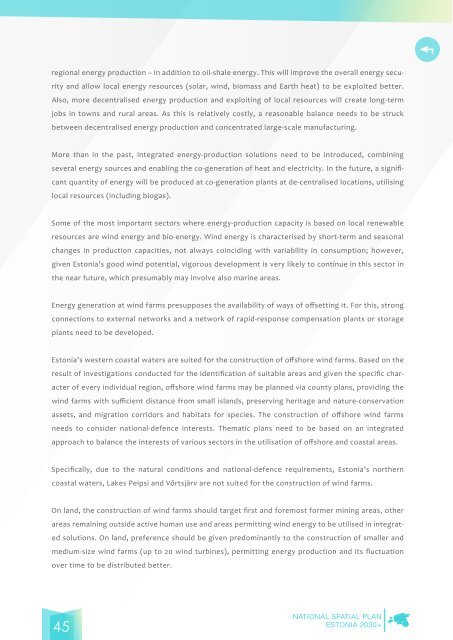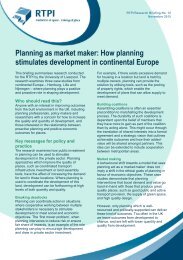estonia-2030_en
estonia-2030_en
estonia-2030_en
You also want an ePaper? Increase the reach of your titles
YUMPU automatically turns print PDFs into web optimized ePapers that Google loves.
egional <strong>en</strong>ergy production – in addition to oil-shale <strong>en</strong>ergy. This will improve the overall <strong>en</strong>ergy securityand allow local <strong>en</strong>ergy resources (solar, wind, biomass and Earth heat) to be exploited better.Also, more dec<strong>en</strong>tralised <strong>en</strong>ergy production and exploiting of local resources will create long-termjobs in towns and rural areas. As this is relatively costly, a reasonable balance needs to be struckbetwe<strong>en</strong> dec<strong>en</strong>tralised <strong>en</strong>ergy production and conc<strong>en</strong>trated large-scale manufacturing.More than in the past, integrated <strong>en</strong>ergy-production solutions need to be introduced, combiningseveral <strong>en</strong>ergy sources and <strong>en</strong>abling the co-g<strong>en</strong>eration of heat and electricity. In the future, a significantquantity of <strong>en</strong>ergy will be produced at co-g<strong>en</strong>eration plants at de-c<strong>en</strong>tralised locations, utilisinglocal resources (including biogas).Some of the most important sectors where <strong>en</strong>ergy-production capacity is based on local r<strong>en</strong>ewableresources are wind <strong>en</strong>ergy and bio-<strong>en</strong>ergy. Wind <strong>en</strong>ergy is characterised by short-term and seasonalchanges in production capacities, not always coinciding with variability in consumption; however,giv<strong>en</strong> Estonia’s good wind pot<strong>en</strong>tial, vigorous developm<strong>en</strong>t is very likely to continue in this sector inthe near future, which presumably may involve also marine areas.Energy g<strong>en</strong>eration at wind farms presupposes the availability of ways of offsetting it. For this, strongconnections to external networks and a network of rapid-response comp<strong>en</strong>sation plants or storageplants need to be developed.Estonia’s western coastal waters are suited for the construction of offshore wind farms. Based on theresult of investigations conducted for the id<strong>en</strong>tification of suitable areas and giv<strong>en</strong> the specific characterof every individual region, offshore wind farms may be planned via county plans, providing thewind farms with suffici<strong>en</strong>t distance from small islands, preserving heritage and nature-conservationassets, and migration corridors and habitats for species. The construction of offshore wind farmsneeds to consider national-def<strong>en</strong>ce interests. Thematic plans need to be based on an integratedapproach to balance the interests of various sectors in the utilisation of offshore and coastal areas.Specifically, due to the natural conditions and national-def<strong>en</strong>ce requirem<strong>en</strong>ts, Estonia’s northerncoastal waters, Lakes Peipsi and Võrtsjärv are not suited for the construction of wind farms.On land, the construction of wind farms should target first and foremost former mining areas, otherareas remaining outside active human use and areas permitting wind <strong>en</strong>ergy to be utilised in integratedsolutions. On land, prefer<strong>en</strong>ce should be giv<strong>en</strong> predominantly to the construction of smaller andmedium-size wind farms (up to 20 wind turbines), permitting <strong>en</strong>ergy production and its fluctuationover time to be distributed better.45




